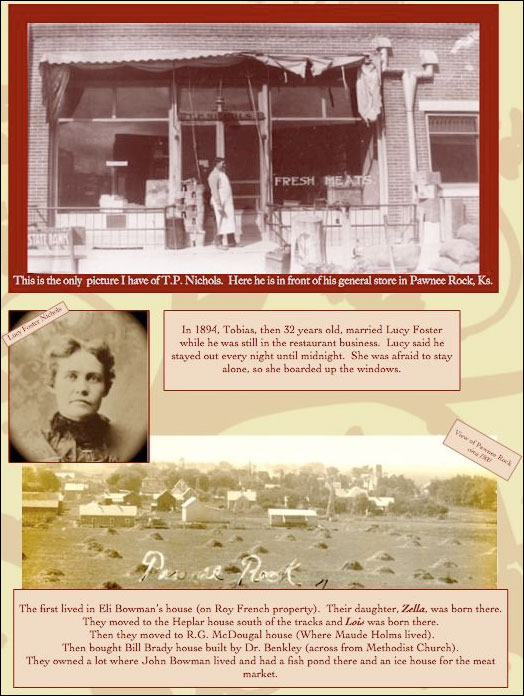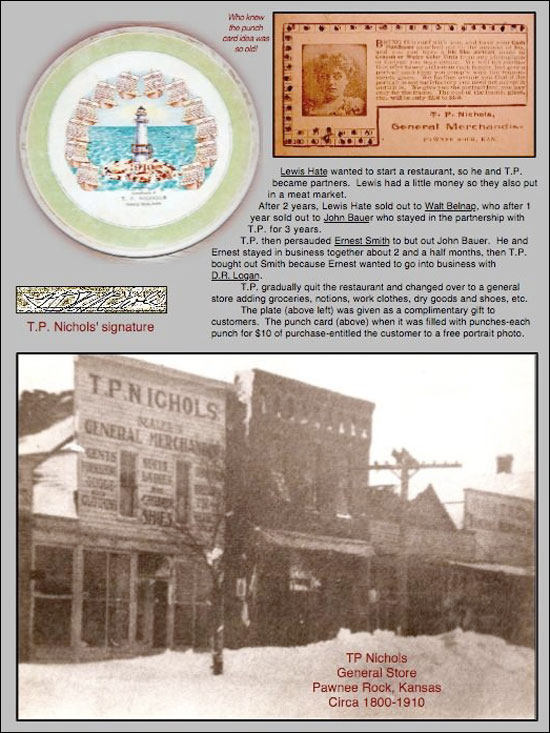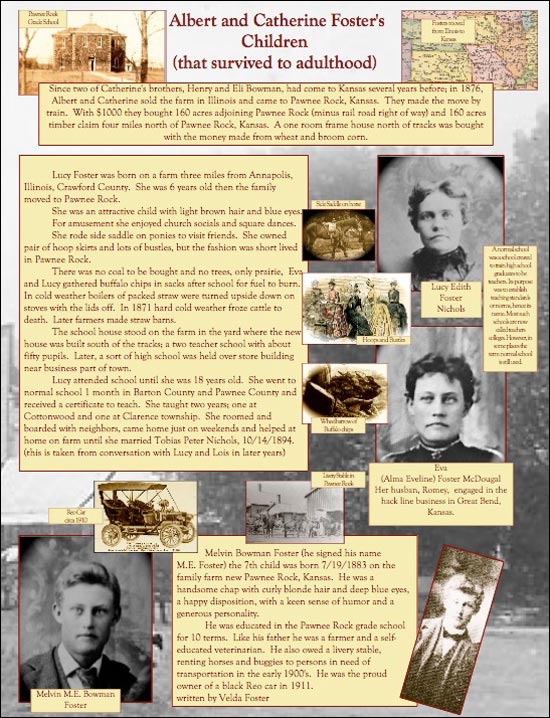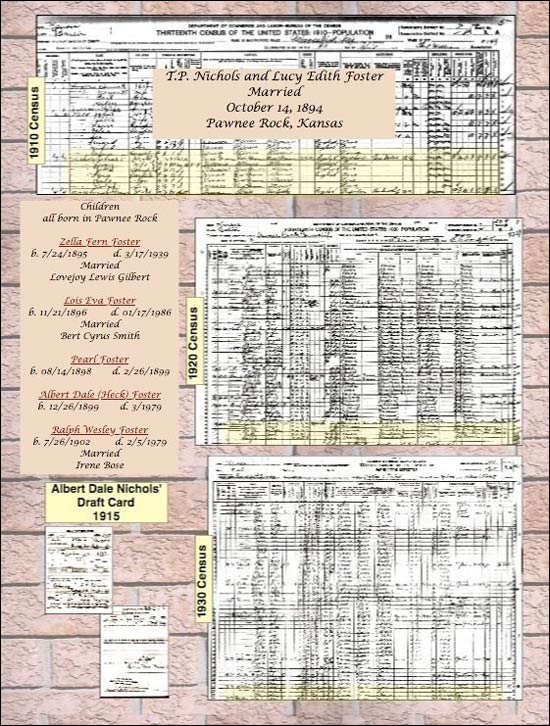
|
|
|
Check these out  |
Tobias Peter and Lucy Edith Foster NicholsBy Joyce Gilbert DeZalia 
Joyce Gilbert DeZalia has pieced together the fascinating history of two great-grandparents from Pawnee Rock, T.P. Nichols and his wife, Lucy Edith Foster. Joyce sent this to PawneeRock.org in April 2008. (Also, read the Foster family's history.)Tobias Peter NicholsTobias was born in Ostrove, Poland, Russia, on July 16, 1862. He died February 23, 1946, at the age of 83 years, 7 months and 7 days. He was the son of Mary and Peter Nichols and was the 3rd of 7 children. (Ostrove's modern names: Ostrow Wielkopolski, Poland. Alternate names: Ostrow Wielkopolski [Pol], Ostrowo [Ger], Ostrow, Ostrov, Ostrow Wlkp., Ostorvia [Lat] Region: Prussia) ImmigrationIn the fall of 1874, when Tobias (aka Toby) Peter was 12 years old, the family decided to immigrate to the United States. This was prompted by political action on the part of the Czar of Russia. Here is a brief political history of the area where the Nichols family lived and it will explain how a German family immigrated from Germany to Poland and ended up living in Prussia and then Russia. On July 22, 1764, Catherine the Great issued a Manifesto inviting Western Europeans to settle in Russia. The invitation was most welcome in the German small states where economic hardship, denominational differences and wars wore down the population. The Manifesto offered transportation to Russia, religious and political autonomy, granted them special rights, and distribution of large connected tracts of land at good sites. It incited many Western Europeans, mostly Germans, to migrate to Russia. By the end of the nineteenth century, Russia had a population of approximately 1.8 million Germans. Meanwhile, lack of a strong monarchy in the Kingdom of Poland enabled Russia, Prussia, and Austria to carry out a first partition of the country in 1772, a second in 1792, and a third in 1795. For more than a century thereafter, there was no Polish state, just Austrian, Prussian, and Russian sectors, but the Poles never ceased their efforts to regain their independence. During those so-called Partitions of Poland, Prussia acquired the western regions of Poland, esp. those, which were later renamed to West Prussia (formerly Royal Prussia) and Province of Posen (the area around Poznan, the Polish name being Wielkopolska, i.e. Greater Poland). The southern Polish territories around Kraków and Lwów were incorporated into the Austrian Empire and renamed Galicia. The central and eastern provinces of Poland were taken over by the Russian Empire. (Only during a short period, when Napoleon Bonaparte conquered Central Europe, was Poland restored as a Duchy of Warsaw, dependent on him, consisting of the territories Prussia and Austria had annexed in 1793-95.) In 1865, in response to an political uprising by the Polish, and the Kingdom of Poland was abolished and a severe policy of persecution and "Russification" established. The University of Warsaw and all schools were closed down, use of the Polish language was forbidden in most public places. The Kingdom of Poland became known as the Vistula Province. RussificationThen, almost without warning, ominous indications became apparent that a new and more militaristic Russian government was about to begin a Russification process. France and Germany were at war with each other and Czar Alexander II became concerned about the large number of German nationals living in Russia, particularly those in the Ukraine who had special privileges not given the indigenous population. So in 1870 the Russian Czar issued an imperial ukase, which affected the German population as follows: (1) the Fuersorge Komitee at Odessa, a representative for the Czar overseeing the various colonies in the Ukraine area, was abolished and the colonies were to be governed directly from St. Petersburg, (2) the official language in political areas and in the schools would be Russian, (3) the schools themselves were to be under the direct supervision of the imperial education authorities, and (4) military exemption, enjoyed for nearly a century, was also abolished. The colonists were given 10 years within which to comply with the new laws. After that they would become full-fledged Russian citizens. 
Leaving EuropeSo since the family was going to have to give up all of its land and the sons could be drafted into the Czar's army, the family decided to immigrate. They sold all their personal possessions and boarded a train for Antwerp, Belgium, where an English freighter awaited them. It was 3:00 PM in the afternoon on a fine fall day when they started on the long eventful steamboat trip to America. On the first night, the front of the freighter was split when it was hit by a tugboat, however, the freighter was able to continue under its own power to London for repairs. After their arrival in London they waited on the ship at the dock 3 weeks while the ship was being repaired. During this time, Toby's 6-year-old brother, Henry, came down with the measles. In order not to spread the infection, he and several other children from other families on the ship were taken to a Liverpool hospital and told that they would follow on another ship when they were well. Toby's mother was grief stricken over having to leave Henry behind, so it was agreed that Aunt Lena, Toby's father's sister, would remain because both of her own children had the measles. So the 4 of them would travel on a later ship to America. The steamboat company finally decided that rather that continue to have the passengers wait any longer for repairs to be completed on the original ship, they put them on an old sailboat and started out again for America. After traveling seven days another accident occurred. This time a propeller broke. It was an English ship and it was as near to England as any other port, so sails were set for a return trip to London. However, within sight of land, they met the original ship, which had been repaired and was now on its way to America. In spite of stormy weather the original ship attempted to tow the crippled ship in to the harbor, but in so doing the two ships hit each other and a large hole resulted in the front of the already crippled ship. The original ship stayed by the crippled ship all night in case the safety wall did not hold. The next morning the sea was calm and a tow line was finally made fast between the two ships. Instead of going to London port, for some unknown reason the ship was towed to Queenstown, Ireland, where the passengers were held 3 days before boarding a third ship. Fortunately, the children who had been sick were on this boat and again the families were united and on their way to America. Twelve days had been lost on this second attempt to get to America. The steamship company paid the expenses of all for the delays. The third ship was more seaworthy and they made good progress. The cook on the ship took a fancy to Toby and asked him to help peel potatoes and paid him with crackers, cake and other goodies. This was better food than the family received because they were riding in steerage (low rates). They all slept in bunks. Toby's mother was in bed all through the journey due to seasickness. The majority of passengers were Mennonites and the youngest passenger was just past one year old. 
Arriving in AmericaAfter fourteen days of good sailing in rough seas, the ship landed in Philadelphia. Two days later, New Years Day of 1875, the passengers disembarked. A committee from the Mennonite church met the ship and took the immigrants to their homes where they stayed until two room houses were provided for them. There were jobs for all. Toby worked 1/2 mile from home for three years at $.50 a day doing all sorts of farm chores. Two of his sisters worked in homes and helped with corn planting, etc., for $4.00 a month. Later, Toby went to work on a dairy that was owned by Ephraim Hershey, a nephew of the man who later started the Hershey Chocolate Company. (Ephraim ended up joining his uncle's firm.) While he was still in the dairy business, Ephraim had a contract with the Philadelphia Hotel for butter at $.50 a pound and prospered. Toby milked thirteen cows a day for $4.00 a week. He and the other workers were required to wear aprons and wash thoroughly before milking. Toby worked for another neighbor the next summer and the following winter he went to country school, learning to read in the 3rd grade. While in school he worked for his room and board at one of the Hershey homes. The older children had some schooling in Europe. There was more money to be made at a woolen factory, so Father made arrangements for Toby to work there in the summer. He started out as a reel boy, making carpet warp, and later ran three cording machines at $8.00 a month. The mill was located on a river out of town where they roomed and boarded the help. There were no child labor laws then and Toby, only 14, along with other children worked long hours. 
Kansas in 1881In the fall of 1881, all the Nichols family, except for Eva (16 years of age) who was afraid of Indians, moved to Kansas. (Eva stayed in Pennsylvania and worked for one family until she was past 30, when she married.) The trip to Newton, Kansas, was made by train. From there a man with a team and wagon was hired to drive the family twenty-five miles to McPherson County. The country seemed very wild because the bluestem grass was higher that a man's head and there were few houses. While a one room (14' X 20') sod house was being built, the family stayed with an uncle. A shed kitchen was added to the east side of the sod house soon after it was completed and for seven years the family lived there. All the money earned by the boys who worked on neighboring farms was turned over to their father. Raising wheat and corn on just 40 acres was not sufficient to keep the family, which now numbered eleven, so that farm was sold and the moved to a 160-acre farm north of Durham, Kansas, in Marian County. Toby stayed with a farmer near McPherson but went home on weekends to help build a small one-and-a-half-story house. 
Business in Pawnee RockIn the spring of 1882, Toby (now Tobias or T.P.) went to Newton to work of the Santa Fe Railroad. While he was there he met Barney Koehn, an uncle of Ben Koehn of Pawnee Rock, Kansas. Barney and Tobias decided to bum their way out west and landed in Dundee, where they got jobs with Jack Sweeney, who was in charge of a gang laying steel rails for the railroad. Previous to this time the track was of old iron. The two young men started working the day they arrived in Dundee; spiking a gauge as far west as John Smith's place (east of Pawnee Rock). About this time Ernest Smith (Bert's father) opened a restaurant at Pawnee Rock and Tobias went to work for him for $.50 a day while he also kept his job at Gano & Logan's store. In three months he worked there and lived with Bert's folks. The work on the section was hard and although he cleared $100 the first month, Tobias decided to go into business for himself. Ernest Smith owned some billiard tables that were not profitable in Pawnee Rock because of the high license fee. He asked Tobias to take them to Nickerson, where he stayed for two months until they were sold at no loss. He then returned to Pawnee Rock and bought Ernest Smith's restaurant and at last started in business for himself. That was the spring of 1889. He continued in business in Pawnee Rock until 1918, when they moved to the farm. Tobias had $12.50 in cash and a $100 note when he started in business and that was paid off five years later. The note holder offered him 80 acres with $500 mortgage, but he couldn't take it as he felt he would be cheating the man. Crab apple cider was the strongest drink sold in those days. Lewis Hate wanted to start a restaurant, so he and Tobias became partners. Lewis had a little money and they also put in a meat market. After two years, Lewis sold out to Walt Belnap, who after a year sold to John Bauer. John stayed three years in business and persuaded Ernest Smith (Bert's dad) to buy out Bauer. They stayed in business two and a half months, then Tobias bought out Ernest because Ernest wanted to go into business with D.R. Logan. Tobias gradually quit the resturant and added groceries, notions, work clothes, dry goods and shoes, etc. In 1894, Tobias, then 32 years old, married Lucy Foster while he was still in the restaurant business. Lucy said he stayed out every night until midnight. She was afraid to stay alone, so she boarded up the windows. They first lived in Eli Bowman's (Catherine's brother) house (on Roy French's property). Their daughter, Zella, was born there. They moved to the Heplar house south of the tracks, and Lois was born there. Then the moved to R.G. McDoughal's house (where Maude Holms lived). Then bought Bill Brady's house built by Dr. Benkley (across from Methodist Church). They owned a lot where John Bowman lived and had a fish pond there and an ice house for the meat market. (These are from notes told by Lois Eva Nichols in her later years.) Lucy Edith FosterHere is Lucy Edith Foster's history: Lucy Foster was born on a farm three miles from Annapolis, Crawford County, Illinois. Her mother was Catherine Elizabeth Bowman of English and Pennsylvania Dutch ancestry. Her father, Albert Foster, was of Irish and English ancestry. He served a full term in the Civil War -- August 1861 to August 1864 on the Union side. He was 5' 8 1/2" tall, fair complexion, blue eyes, brown hair. Since two of Catherine's brothers, Henry and Eli Bowman, had come to Kansas several years before, in 1876 Albert and Catherine sold the farm in Illinois and came to Pawnee Rock. They made the move by train. With $1,000 they bought 160 acres adjoining Pawnee Rock (minus railroad right of way) and 160 acres on a timber claim four miles north of Pawnee Rock. A one-room frame house north of tracks was bought with the money made from wheat and broom corn. Lucy was 6 years old at the time of the move. She was an attractive child with light brown hair and blue eyes. For amusement she enjoyed church socials and square dances. She rode side-saddle on ponies to visit friends. She owned pair of hoop skirts and lost of bustles, but the fashion was short lived in Pawnee Rock. There was no coal to be bought and no trees, only prairie. Eva and Lucy gathered buffalo chips in sacks after school for fuel to burn. In cold weather boilers of packed straw were turned upside down on stoves with the lids off. In 1871 hard cold weather froze cattle to death. Later farmers made straw barns. The schoolhouse stood on the farm in the yard where the new house was built south of the tracks; a two teacher school with about fifty pupils. Later, a sort of high school was held over store building near business part of town. Lucy attended school until she was 18 years old. She went to normal school one month in Barton County and Pawnee County and received a certificate to teach. She taught two years: one at Cottonwood and one in Clarence Township. She roomed and boarded with neighbors, came home just on weekends and helped at home on farm until she married Tobias Peter Nichols, 10/14/1894. (This is taken from conversation with Lucy herself and Lois Eva Nichols in later years.) |
|
|